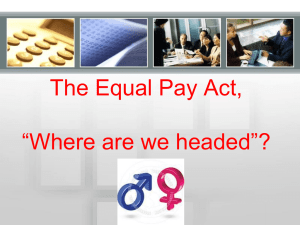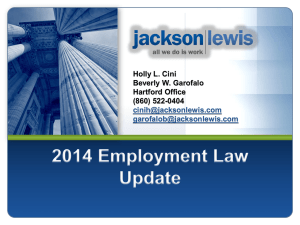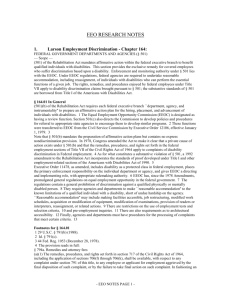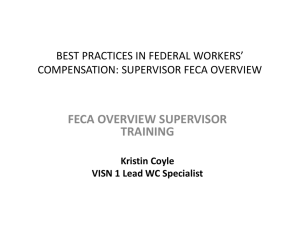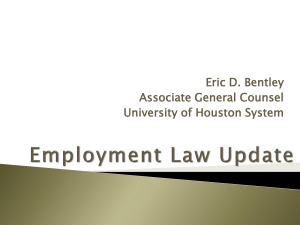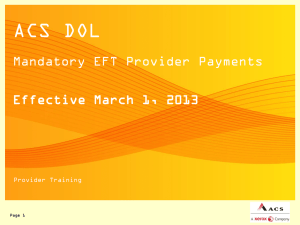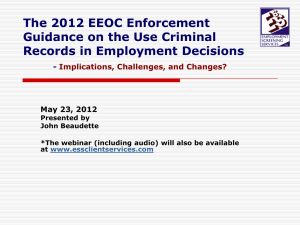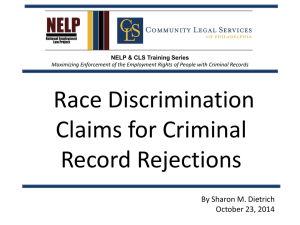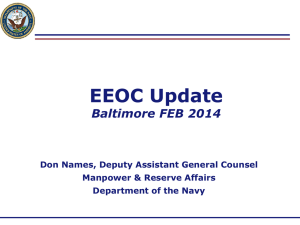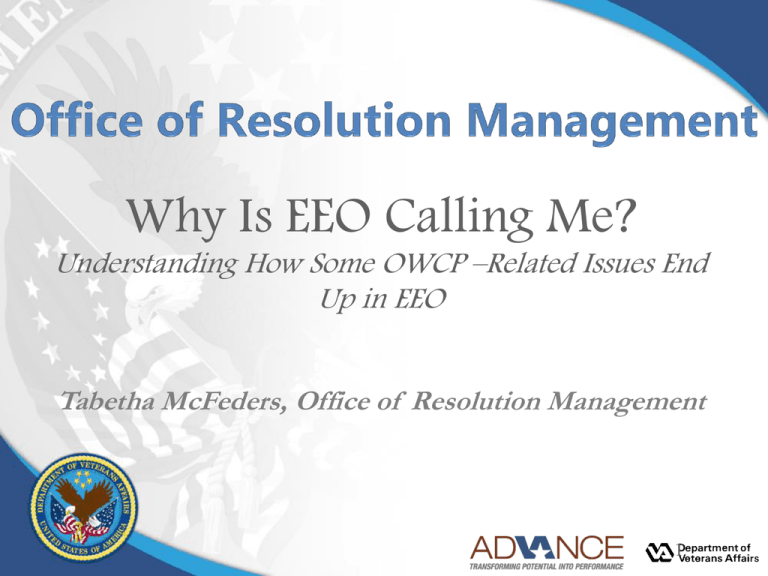
Why Is EEO Calling Me?
Understanding How Some OWCP –Related Issues End
Up in EEO
Tabetha McFeders, Office of Resolution Management
1
Objectives
• Identify the right rules that apply for non-work related
injury and illness.
• Understand obligation to reasonably accommodate injured
employees.
• Identify what parts of the EEO complaint process worker’s
compensation program managers and supervisors may be
asked to participate in.
• Identify worker’s compensation issues that are always
excluded from the EEO complaint process.
2
Occasional Overlap
• On-the-job injuries
• Reasonable accommodation
3
Identify the Right Rules
• Is the medical condition work-related or nonwork-related?
• Is the medical condition minor and temporary?
• Does the employee meet the definition of
disability under the Americans With Disabilities
Amendments Act (ADAAA) due to the medical
condition?
4
Federal Employees’ Compensation Act 5
U.S.C. 8101 et seq.
FECA provides compensation benefits to civilian
employee of the United States for disability due
to personal injury or disease sustained while in
the performance of duty. FECA is intended to be
remedial in nature, and proceedings under it
are non-adversarial.
5
Americans with Disabilities Act Amendments Act
(ADAAA)/Rehabilitation Act
Reasonable Accommodation
• ADAAA requires an employer to make a reasonable
accommodation to the known disability of a qualified
applicant or employee if it would not impose an "undue
hardship" on the operation of the employer's business.
– Undue hardship is defined as an action requiring significant
difficulty or expense when considered in light of factors such as an
employer's size, financial resources, and the nature and structure
of its operation.
6
Identify the Right Rules (for work related
injury and illness)
• Is the medical condition work-related or non
work related?
– Work-related injuries are covered by the Federal Employees
Compensation Act (FECA) and the rules to follow are found in
20 CFR Part 10.
– The Office of Workers Compensation Programs, U.S.
Department of Labor, will make all decisions regarding claims
of work-related medical conditions.
7
Identify the Right Rules (non workrelated medical conditions)
• Is the medical condition minor and transitory?
– Individual agency policies, Federal regulations (5 CFR
630) and Bargaining Unit Agreements cover temporary,
non-work-related medical conditions, where the
employee wants to use accrued sick or annual leave.
– Permanent non-work-related medical conditions,
where the employee requires extensive time off from
work to recover from a serious injury or illness for
themselves or their family are covered by the Family
and Medical Leave Act (FMLA). These rules are also
found in 5 CFR 630.
8
Identify the Right Rules (non work-related
medical condition)
• Does the medical condition define the
employee as a qualified handicapped employee
under the ADAAA?
– Non-work-related medical conditions, where the employee
requires modification of their job to accommodate a
significant disability are covered by the ADAAA. In order to
be entitled to coverage under this statute, the employee
must suffer from a medical condition that substantially
impairs a major life activity. Conditions that are both minor
and transitory are not covered.
9
Do I Have to Accommodate an
Employee Who Has an OWCP Claim?
YES!
• Agencies still have an obligation to engage in
the interactive process with an employee even
if that employee is on OWCP or has a claim
pending.
10
Consequences…..
Granting benefits or accommodations to
employees who do not qualify, results in
reduced staffing efficiency; reduced morale in
employees who must perform the work of the
employee receiving unearned benefits; and may
well cause discrimination complaints of
disparate treatment by other employees who
were not afforded similar benefits for similar
reasons.
11
Question
I thought employees could not use the EEO
complaint process to launch an attack on the
workers’ compensation process! Why am I
being contacted by someone from the EEO
office?
12
Answer
• Once an employee engages the OWCP path, it
should be followed to its conclusion.
• Confusion occurs when employees use the EEO
complaint process to question or attack what
occurred during the OWCP process.
– The complaint process does not allow for collateral
attacks on the OWCP process.
13
Question
• So, if collateral attacks are not permitted, why
is an EEO counselor calling me?
14
Answer
• The answer lies (partly) in the structure of the
EEO complaint process.
15
How Does the EEO Complaint
Process Work?
• Informal Stage
– Traditional EEO Counseling
– ADR
• Formal Stage
16
Why an EEO Counselor May Contact
You…
• The informal process has no mechanism to
deny EEO counseling to an individual regardless
of the issue
• Counselor’s responsibility is to educate on the
appropriate forum of a complaint
17
What To Expect During EEO
Counseling
• Counselor determines the claims and bases from the
aggrieved employee.
• You will be asked about your role in the issue/claim.
• Counselor tries to resolve the issue(s) by speaking with
the aggrieved employee, and management officials.
• You may be asked to participate in alternative dispute
resolution (ADR).
18
What is ADR?
• Alternative dispute resolution is a valuable
resource in managing conflict and resolving
disputes. ADR processes, such as mediation,
foster open communication and respect in the
workplace.
– Valuable to resolve any dispute NOT just EEOrelated.
19
What Happens if the Issues Are Not Resolved
During Counseling or Through ADR?
The aggrieved employee is advised of his/her
right to file a formal complaint.
20
What Happens When a Formal
Complaint is Filed?
• Complaint is reviewed to determine if it is
acceptable for investigation
• OWCP-related claims will be analyzed based on
EEO and other relevant case-law
21
What Matters Fall Under
EEOC’s Jurisdiction
• The Equal Employment Opportunity Commission (EEOC)
regulation 29 CFR 1614.107 allows for the dismissal of
claims that:
–
–
–
–
–
–
–
–
–
Fails to state a claim
Fails to meet time limits
Is the basis of a pending civil action
Where the complaint has raised the matter in a grievance
procedure or MSPB
Is moot
Where complainant cannot be located
Where the complainant fails to respond to a request for additional
information
Alleges dissatisfaction with the processing of a previous claim
Abuse of complaint process
22
What “States a Claim”?
• Individuals may file a complaint of employment
discrimination and retaliation prohibited by
Title VII of the Civil Rights Act of 1964
(discrimination on the basis of race, color,
religion, sex and national origin), the Age
Discrimination in Employment Act (age),
Rehabilitation Act, Americans with Disabilities
Act and/or the Equal Pay Act.
23
Question
Do OWCP-related claims state a claim?
24
Answer
It depends!
25
EEOC Decisions Preventing
Collateral Attacks
• Story V. U.S.P.S. (EEOC No. 05960314)
– Claimant may not use the EEO process to launch a collateral attack on the
workers’ compensation process. It is within OWCP’s jurisdiction to determine
whether a compensation claim has merit, and OWCP claims are not appealable
to EEOC.
• Hogan V. Army (EEOC No 01975337)
– An agency has a right to represent its position and interest in the OWCP forum
and EEOC will not review decisions which require judgment of the merits of the
OWCP claim.
• Andel v. U.S.P.S. (EEOC No. 01975337)
– An agency has an obligation to controvert an employee’s workers’ compensation
claim. Controversion of the claim does not affect a term, condition of
employment. Andel alleged the agency provided false information to OWCP.
EEOC ruled this was a collateral attack on the workers’ compensation claim
processing.
26
Question
• If there is EEOC case law preventing collateral
attacks on the OWCP process, then why are
some complaints accepted?
27
Answer
• Other EEOC decisions have found that some
OWCP-related complaints state a claim.
28
Case Law Where OWCP Complaints
State a Claim
• EEOC decisions where OWCP issues state an EEO
claim:
– Brizenzo v.VA (EEOC No. 01A14841)
• An allegation that the agency willfully failed to provide
information to OWCP on a discriminatory basis
– Villa v. Treasury (EEOC No. 01994737)
• An allegation that a supervisor used the worker’s compensation
process in a discriminatory manner compared to other
employees
– Glover v. U.S.P.S. (EEOC No. 01A04428)
• An allegation that the agency does not provide promotional
opportunities to disabled individuals who are placed in
permanent rehabilitation duty positions as the result of an onthe job-injury does not constitute a collateral attack on the
OWCP process
– Muhammad v. U.S.P.S. (EEOC No. 01A03678)
• An allegation that the agency failed to provide necessary
information to OWCP to process a claim.
29
Why the Confusion?
• Harris v. VA (EEOC No. 0120064696)
– 2 allegations
• A. Agency officials notified OWCP that she violated her light duty
restrictions.
• B. No selection had been made for 2 positions for which she applied and
were in her light duty restrictions.
– EEOC upheld dismissal of allegation A.
– EEOC reversed dismissal of allegation B finding that the allegation is that
the agency failed to accommodate her.
• Wright v. U.S.P.S. (EEOC No. 0120054949)
– Allegation that agency failed to comply with OWCP decision and resulted
in her having to use annual and sick leave. EEOC reversed agency
dismissal and found it was a viable claim.
30
So If the Complaint States a Claim, What
Can You Expect When A Claim is Accepted?
• Investigative Stage
– Investigator will take testimony or ask you to
submit a written affidavit regarding the issue.
• Given under oath
– You may be asked to provide documentation
• Medical records
31
Question
Do you have to provide files of injured
employees when requested by an EEO
investigator?
32
How do you get the information
that you need?
Agencies may not use copies of information from claim
files in connection with EEO complaints, disciplinary
actions, or other administrative actions without the
employee's consent. Any questions concerning use or
release of records should be directed to the district
office.
Publication CA-810
9-2. Inspection and Protection of Records
33
Access to FECA Records
• Who maintains control of FECA records?
All records relating to claims for benefits filed under the
FECA, including any copies of such records maintained by an
employing agency, are covered by the government-wide
Privacy Act system of records entitled DOL/GOVT-1 (Office of
Workers' Compensation Programs, Federal Employees'
Compensation Act File). This system of records is maintained
by and under the control of OWCP, and, as such, all records
covered by DOL/GOVT-1 are official records of OWCP.
34
What Happens After Investigation?
• Hearing Stage
– Conducted by EEOC Administrative Judge
– Sworn testimony is provided
35
Who Makes the Final Decision on Whether
Discrimination Occurred?
• If a case goes to a hearing, the administrative judge
issues a decision.
– Agency has 30 days to either accept it or appeal it.
• If a case does not go to a hearing, the agency issues a
final decision.
• Complainants are provided appeal rights to EEOC
• Complainants have the right to file in U.S. District
Court.
36
Bottom Line
• You may be contacted by an EEO counselor
about one of your OWCP cases.
– View this as an opportunity for resolution
• While most claims related to OWCP are
dismissed, some may be accepted and you will
be contacted by an investigator and may have
to provide testimony in an EEOC hearing.
37
Resources
EEOC policy guidance on ADA and Reasonable Accommodation
www.eeoc.gov/laws/guidance/subject.cfm#ada
Information specific to the ADA Amendments Act
www.eeoc.gov/laws/statutes/adaaa_info.cfm
EEOC Enforcement Guidance: Workers’ Compensation and the ADA
www.eeoc.gov/policy/docs/workcomp.html
VA Directive and Handbook 5975.1: Processing Requests for Reasonable
Accommodation
www.diversity.va.gov/policy/dra.aspx
Job Accommodation Network
http://janweb.icdi.wvu.edu
Computer/Electronics Accommodations Program
http://www.cap.mil
38
Questions?
39

